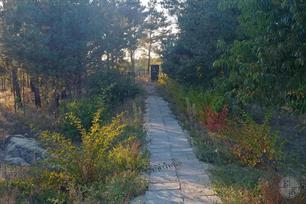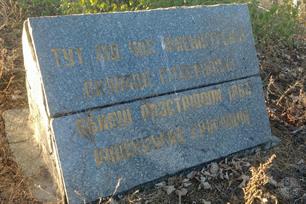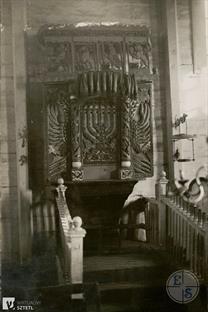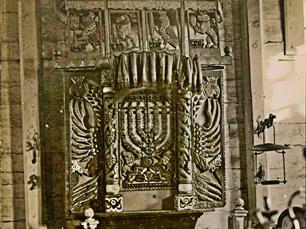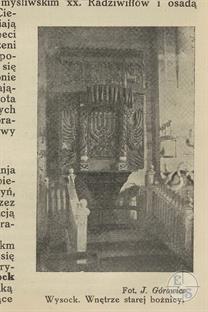Vysotsk
Sarny district, Rivne region
Sources:
- Russian Jewish encyclopedia. Translated from Russian by Eugene Snaider;
- Jewish encyclopedia of Brockhaus & Efron
- Virtual Shtetl. Wysock
- Fialkov (ed.), Ajaratenu Wisotsk; sefer zikaron, Haifa 1963
- Słownik Geograficzny Krуlestwa Polskiego i innych krajуw słowiańskich, vol. 14, Warszawa 1895
- I.Altman (ed.), Holokost na tieritorii SSSR, Moscow 2009
- Biblioteka Narodowa Polona. Michal Marczak, Przewodnik po Polesiu, Brzesc nad Bugiem 1935
- Yad Vashem. Wysock
Photo:
- European Jewish Cemeteries Initiative. Vysotsk. Published by Center for Jewish Art
- Jozef Gorowicz. Wysock, synagoga, aron ha-kodesz (1933). Muzeum Narodowe Gdansk. Published by Virtual Shtetl
- Russian Jewish encyclopedia. Translated from Russian by Eugene Snaider;
- Jewish encyclopedia of Brockhaus & Efron
- Virtual Shtetl. Wysock
- Fialkov (ed.), Ajaratenu Wisotsk; sefer zikaron, Haifa 1963
- Słownik Geograficzny Krуlestwa Polskiego i innych krajуw słowiańskich, vol. 14, Warszawa 1895
- I.Altman (ed.), Holokost na tieritorii SSSR, Moscow 2009
- Biblioteka Narodowa Polona. Michal Marczak, Przewodnik po Polesiu, Brzesc nad Bugiem 1935
- Yad Vashem. Wysock
Photo:
- European Jewish Cemeteries Initiative. Vysotsk. Published by Center for Jewish Art
- Jozef Gorowicz. Wysock, synagoga, aron ha-kodesz (1933). Muzeum Narodowe Gdansk. Published by Virtual Shtetl
In the 16-18 centuries - the township of Pinsk powiat of Brest Voivodeship as part of the Commonwealth. Since 1793 - as part of the Russian Empire. In the 19th - beginning of the 20th century - the township of the Rivne district of the Volyn province.
In 1919–39 - in the Volyn Voivodeship as part of Poland, in 1939–91 - as part of the Ukrainian SSR.
In 1766, 85 Jews lived in Vysotsk,
in 1847 - 320,
in 1897 - 880 (96.4%),
In 1921 - 893 Jews (30%).
The beginning of the Jewish settlement in Vysotsk took place probably in the 17th century. The local community was subordinate to the Jewish community in Pińsk (Belarusian: Pinsk). It is possible that the settlement of Jews in Vysotsk actually constituted a part of a conscious effort by that particular community. In the book of remembrance, Arie Fialkov writes: “Pińsk’s influence resulted from the fact that it established settlements (colonies) in Polesie, which were linked to the metropolis of Pińsk in the field of law and taxes.”
Around 1764, Vysotsk became independent as a community. At the time, there were approximately 85 “Jewish souls” there. The 1774 vetting report mentions seven Jewish landlords who paid the castle rent, which amounted to 16.23 zlotys per year.
Słownik Geograficzny Krуlestwa Polskiego i innych krajуw słowiańskich describes Vysotsk in the late 19th century as a town with a noticeable Jewish presence: “It includes 217 houses, 1,702 Orthodox residents, up to 100 Evangelicals, not counting the Jews, of whom there are many”. From the same source, we learn that a synagogue stood there in 1877. “Local Jews are engaged in the trade of berries, blackberries, and cranberries, as well as mushrooms growing in the forests, on a large scale. Each year, they send several bajdaks filled with these products to Kyiv and Odesa”.
According to the 1897 census, there were 912 people living in the town, including 880 Jews (96.5%!). Later, these proportions changed quickly, perhaps as a result of including areas previously considered rural in Vysotsk. In 1906, the population was already reported to be 2,668, living in 180 houses.
In 1919–39 - in the Volyn Voivodeship as part of Poland, in 1939–91 - as part of the Ukrainian SSR.
In 1766, 85 Jews lived in Vysotsk,
in 1847 - 320,
in 1897 - 880 (96.4%),
In 1921 - 893 Jews (30%).
The beginning of the Jewish settlement in Vysotsk took place probably in the 17th century. The local community was subordinate to the Jewish community in Pińsk (Belarusian: Pinsk). It is possible that the settlement of Jews in Vysotsk actually constituted a part of a conscious effort by that particular community. In the book of remembrance, Arie Fialkov writes: “Pińsk’s influence resulted from the fact that it established settlements (colonies) in Polesie, which were linked to the metropolis of Pińsk in the field of law and taxes.”
Around 1764, Vysotsk became independent as a community. At the time, there were approximately 85 “Jewish souls” there. The 1774 vetting report mentions seven Jewish landlords who paid the castle rent, which amounted to 16.23 zlotys per year.
Słownik Geograficzny Krуlestwa Polskiego i innych krajуw słowiańskich describes Vysotsk in the late 19th century as a town with a noticeable Jewish presence: “It includes 217 houses, 1,702 Orthodox residents, up to 100 Evangelicals, not counting the Jews, of whom there are many”. From the same source, we learn that a synagogue stood there in 1877. “Local Jews are engaged in the trade of berries, blackberries, and cranberries, as well as mushrooms growing in the forests, on a large scale. Each year, they send several bajdaks filled with these products to Kyiv and Odesa”.
According to the 1897 census, there were 912 people living in the town, including 880 Jews (96.5%!). Later, these proportions changed quickly, perhaps as a result of including areas previously considered rural in Vysotsk. In 1906, the population was already reported to be 2,668, living in 180 houses.
In 1901, from an article by B. Abelson in Ha-Cefira, we learn about the dire economic situation of the local community, of – according to the author – approximately 250 Jews. Most of them were craftsmen (tailors and shoemakers, who also performed construction work during winter), and there were also a few merchants travelling through the neighbouring villages. Their incomes were low; many were affected by unemployment; there was even a shortage of water as the Horyn River was too far from the town.
The only social institution was an almshouse, founded back in the 19th century by a rabbi (most probably Rabinowicz) at the turn of the century, which was in a very poor condition. The pre-existing self-help society did not survive until 1901. The only doctor commuted twice a week from Dąbrowica (Ukrainian: Dubrovytsia), but soon, there were no funds to pay him. Wysock was clearly inferior even to the neighbouring shtetls: Stolin to the north and Dąbrownica to the south. In this situation, emigration was a frequent choice, both to Sarny and Rivne as well as much further abroad.
Spiritually, the Hasidic Jews – followers of the Karlin-Stolin dynasty and the Tzadik of Bereźne (Ukrainian: Berezne) were the dominating groups. We know the last three rabbis of the town from the 19th and 20th centuries: Mojżesz Rabinowicz, known as reb Mushke (1880s); Jehuda Abelson of Pietrykуw (Ukrainian: Petrykiv) (who was famous, among other things, for reconciling the followers of the two dominant Hasidic groups); and his son Jehoszua Abelson, who held the ministry until the Holocaust.
It was not until the Second Polish Republic that significant changes were introduced to Vysotsk. In 1921, there were approximately 2,978 people in the town, living in 471 houses; there were 893 Jews – almost exactly 30%.
The first institutions have emerged. The activation of Zionists resulted in the establishment of a Hebrew school and a library with a Hebrew and Yiddish book collection. Organizations of a political nature have emerged: Poale Zion, Tze’irei Zion, HeHalutz Hatzair. Funds were raised for Keren Kajemet le-Israel and Keren Hayesod.
There were also people from non-Zionist groups: Orthodox, Bund, and even communists. However, economic life continued to be local. Its most prominent representatives included a cattle trader from Zamorocze (Ukrainian: Zamorochennya) J. [Jehuda?] Fiszman and the miller J. Feldman.
The community in Vysotsk probably included the neighbouring village of Lutynsk (Ukrainian: Lyutyns’k). In 1930, Jews from two families ran mills (F. Perelsztajn, N. Perelsztajn) and grocery shops here (N. Fiszman, W. Fiszman, N. Perelsztajn).
In 1939, Vysotsk came under the Soviet occupation.
German troops occupied Vysotsk on July 17, 1941.
Following the German occupation, all the Jews were registered, and the town's new authorities passed a series of anti-Jewish decrees. The Jews were required to pay a large ransom, hand over their furs and large amounts of property, wear an armband with the word "Jude" (which was replaced with a yellow badge in late September), and perform forced labor. The summer of 1941 saw the establishment of a twelve-member Jewish council (Judenrat) headed by Yitshak Goldberg, and a small Jewish police force.
In August 1941, some 170 Jewish women and children arrived in Vysotsk from nearby Dawidgródek. They had been driven out of that town following the mass shooting of the local men by an SS cavalry unit.
Sometime before the summer of 1942, a group of about 150 Jews from the surrounding villages were moved into Vysotsk. They were distributed among the residences of the local Jews.
In late July 1942, a ghetto was established in Vysotsk. It was fenced off with barbed wire, and housed a total of about 1,500 inmates: some 1,200 Jews from Vysotsk itself, some 170 Jews from Horodek, and some 150 Jews from nearby villages. Epidemics, especially typhus, soon broke out in the ghetto.
The Vysotsk Ghetto was liquidated on September 9, 1942, and its inmates were shot outside the town, on the bank of the Horyn River, by various German units that were assisted by the Ukrainian Auxiliary Police.
During this murder operation, some Jews tried to escape by swimming across the Horyn River. A number of them managed to reach the opposite bank, while others drowned or were shot dead in the water.
The only social institution was an almshouse, founded back in the 19th century by a rabbi (most probably Rabinowicz) at the turn of the century, which was in a very poor condition. The pre-existing self-help society did not survive until 1901. The only doctor commuted twice a week from Dąbrowica (Ukrainian: Dubrovytsia), but soon, there were no funds to pay him. Wysock was clearly inferior even to the neighbouring shtetls: Stolin to the north and Dąbrownica to the south. In this situation, emigration was a frequent choice, both to Sarny and Rivne as well as much further abroad.
Spiritually, the Hasidic Jews – followers of the Karlin-Stolin dynasty and the Tzadik of Bereźne (Ukrainian: Berezne) were the dominating groups. We know the last three rabbis of the town from the 19th and 20th centuries: Mojżesz Rabinowicz, known as reb Mushke (1880s); Jehuda Abelson of Pietrykуw (Ukrainian: Petrykiv) (who was famous, among other things, for reconciling the followers of the two dominant Hasidic groups); and his son Jehoszua Abelson, who held the ministry until the Holocaust.
It was not until the Second Polish Republic that significant changes were introduced to Vysotsk. In 1921, there were approximately 2,978 people in the town, living in 471 houses; there were 893 Jews – almost exactly 30%.
The first institutions have emerged. The activation of Zionists resulted in the establishment of a Hebrew school and a library with a Hebrew and Yiddish book collection. Organizations of a political nature have emerged: Poale Zion, Tze’irei Zion, HeHalutz Hatzair. Funds were raised for Keren Kajemet le-Israel and Keren Hayesod.
There were also people from non-Zionist groups: Orthodox, Bund, and even communists. However, economic life continued to be local. Its most prominent representatives included a cattle trader from Zamorocze (Ukrainian: Zamorochennya) J. [Jehuda?] Fiszman and the miller J. Feldman.
The community in Vysotsk probably included the neighbouring village of Lutynsk (Ukrainian: Lyutyns’k). In 1930, Jews from two families ran mills (F. Perelsztajn, N. Perelsztajn) and grocery shops here (N. Fiszman, W. Fiszman, N. Perelsztajn).
In 1939, Vysotsk came under the Soviet occupation.
German troops occupied Vysotsk on July 17, 1941.
Following the German occupation, all the Jews were registered, and the town's new authorities passed a series of anti-Jewish decrees. The Jews were required to pay a large ransom, hand over their furs and large amounts of property, wear an armband with the word "Jude" (which was replaced with a yellow badge in late September), and perform forced labor. The summer of 1941 saw the establishment of a twelve-member Jewish council (Judenrat) headed by Yitshak Goldberg, and a small Jewish police force.
In August 1941, some 170 Jewish women and children arrived in Vysotsk from nearby Dawidgródek. They had been driven out of that town following the mass shooting of the local men by an SS cavalry unit.
Sometime before the summer of 1942, a group of about 150 Jews from the surrounding villages were moved into Vysotsk. They were distributed among the residences of the local Jews.
In late July 1942, a ghetto was established in Vysotsk. It was fenced off with barbed wire, and housed a total of about 1,500 inmates: some 1,200 Jews from Vysotsk itself, some 170 Jews from Horodek, and some 150 Jews from nearby villages. Epidemics, especially typhus, soon broke out in the ghetto.
The Vysotsk Ghetto was liquidated on September 9, 1942, and its inmates were shot outside the town, on the bank of the Horyn River, by various German units that were assisted by the Ukrainian Auxiliary Police.
During this murder operation, some Jews tried to escape by swimming across the Horyn River. A number of them managed to reach the opposite bank, while others drowned or were shot dead in the water.

- Home
- Shtetls
- Vinnytsia region
- Volyn region
- Dnipro region
- Donetsk region
- Zhytomyr region
- Zakarpattia region
- Zaporizhzhia region
- Ivano-Frankivsk region
- Kyiv region
- Kropyvnytskyi region
- Luhansk region
- Lviv region
- Mykolayiv region
- Odessa region
- Poltava region
- Rivne region
- Sumy region
- Ternopil region
- Kharkiv region
- Kherson region
- Khmelnytskyi region
- Chernihiv region
- Chernivtsi region
- Cherkasy region
- Crimea
- Synagogues
- Cemeteries
- Objects & guides
- Old photos
- History
- Contact
Jewish towns of Ukraine
My shtetl
My shtetl
Donate
Jewish towns of Ukraine
